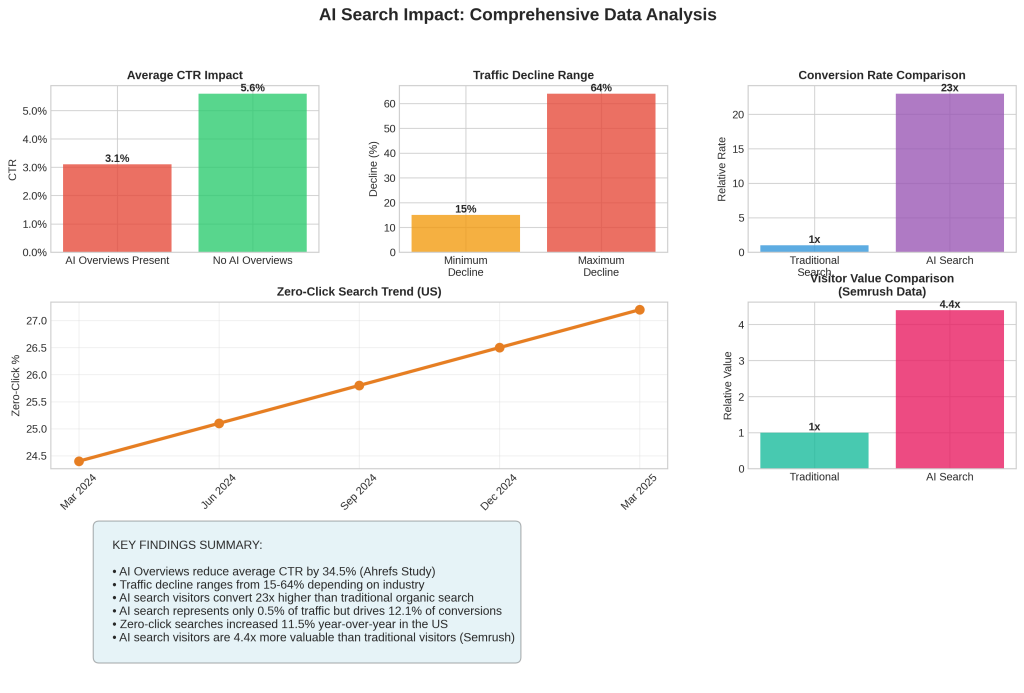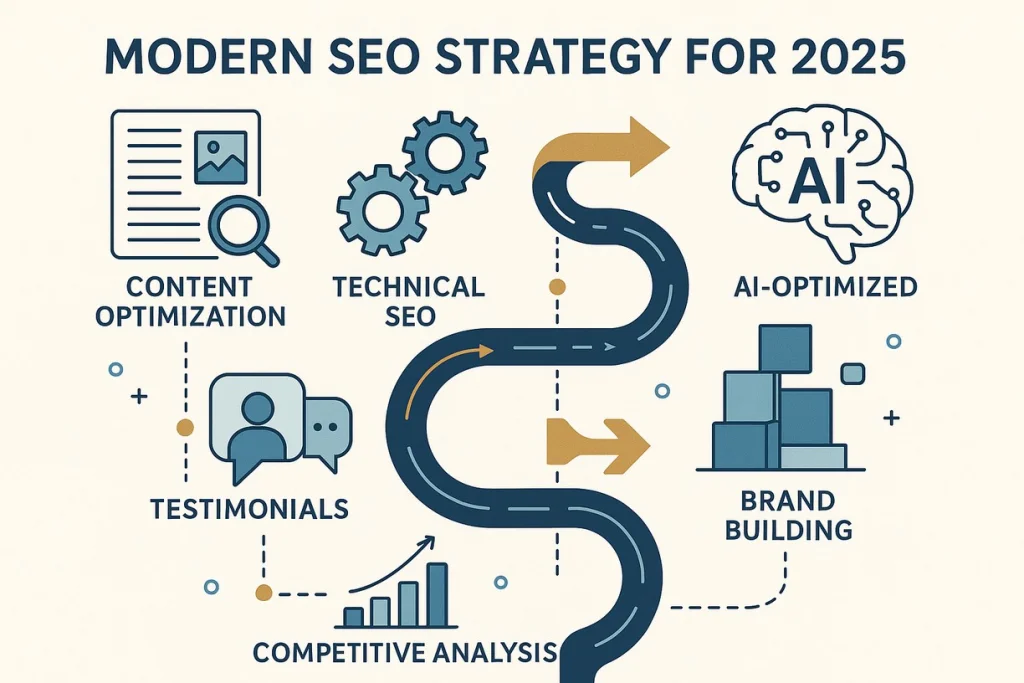Understanding the AI Paradox in SEO
The digital marketing landscape of 2025 seems to present us with a fascinating contradiction. As AI-powered search features dramatically reduce organic click-through rates, the visitors who engage with websites are converting at higher levels. This phenomenon represents a fundamental shift from quantity-focused to quality-driven SEO strategies.
The Impact of AI on Click-Through Rates
The effect of AI’s impact on click-through rates seems to depend on who you ask and what industry you are in. There seem to be four camps of opinion on what is going on:
- There are those who are saying things really have changed little.
- Those who are saying it’s over; SEO is dead.
- People who say we need a unique approach using AEO (Answer Engine Optimization).
- Those saying there are some big changes going on, so we need to tweak our current strategy to keep up.
I’m in the last (#4) camp, and this article is my explanation why.
How AI Overviews are Changing User Behavior

In my opinion, things look different on paper right now, but I think the same thing is still happening. Before AIOs, potential customers would educate themselves about your business on your website. That’s why you wrote informational content. Then, after researching other businesses, they would come back to your website (hopefully!) and become a customer.
Now they’re reading the informational content on the AI platforms, and when they’re ready to buy, they click through to their eventual choice. The thing is that the informational content still needs to come from somewhere. Wouldn’t you like it to be your brand they see in the AI? Of course you do.
I thought AI search answers almost always drew from the first SERP results page. In an extensive study on where AI search answers come from, conducted by Louise Linehan and Xibeijia Guan, they found out something that should give us all some optimism. The study found that 76.10% of AI citations came from the top 10 results, 9.50% came from positions 11-100, and that 14.40% of the citations didn’t even rank in the top 100. That means that almost 25% of the citations weren’t in the top 10 results! Should we continue doing SEO? I definitely am.
Quality vs. Quantity: The New Metrics of Success
When AI systems provide immediate answers to basic queries, they effectively filter out casual browsers and information seekers, leaving behind users with specific commercial or research intent.
This filtering effect creates a more efficient marketplace for both businesses and consumers. Users who click through after viewing AI-generated summaries typically clearly understand what they’re looking for and are closer to deciding. For businesses, this means higher engagement rates, longer session durations, and significantly improved conversion metrics.
So far almost all the studies are about how AI traffic has a higher conversion rate than traffic directly from Google, but I suspect that the traffic from Google has gone up in conversion value as well for the same reason; the research was already done in the AI overviews.
Adapting Your SEO Strategy for 2025

Optimizing for Zero-Click Searches
Rather than viewing zero-click searches as lost opportunities, forward-thinking businesses recognize them as brand-building moments. When content appears in AI Overviews, it establishes authority and credibility even without generating immediate clicks. This exposure creates long-term value through brand recognition and trust building.
Even when users don’t click immediately, they associate the brand with helpful, reliable information. This association becomes valuable when users are ready to make purchasing decisions or seek more detailed guidance.
Effective zero-click optimization requires understanding the queries that generate AI Overviews and creating content that directly addresses these information needs. The goal is to become the primary source that AI systems reference when generating responses.
Creating Content for AI-Driven Search Results
Successful content architecture involves organizing information in a way that AI can easily parse and summarize. This means using descriptive headings, providing clear definitions, and structuring information to flow logically from general concepts to specific details.
The technical aspects of AI-friendly content include proper use of structured data markup, clear semantic HTML, and content organization that facilitates machine understanding. However, the most important factor remains creating genuinely useful content that addresses real user needs comprehensively.
New Metrics for Measuring SEO Success
Why Traditional SEO Metrics Are No Longer Effective

The limitations of traditional SEO metrics become apparent when considering the quality differential in AI-driven traffic. A website receiving 10,000 monthly visitors with a 2% conversion rate generates 200 conversions, while a site receiving 1,000 visitors with a 20% conversion rate also achieves 200 conversions. Same results, but they look completely different in your analytics!
We need to pay attention to visitor quality, engagement depth, and long-term value creation. Metrics such as pages per session, time on site, and conversion rate become a more meaningful way to measure success than raw traffic volume.
The challenge lies in developing measurement systems that capture both immediate performance and long-term brand-building effects. This includes tracking brand mention frequency in AI results, measuring share of voice in AI-generated content, and assessing the correlation between AI visibility and business outcomes.
Emphasizing Impression Over Clicks
Impression-based metrics are gaining importance as businesses recognize the brand-building value of appearing in AI Overviews. Even when users don’t click through to websites, seeing a brand associated with authoritative information creates valuable mental associations that influence future decision-making.
This concept extends traditional impression metrics to include AI-generated content appearances. When AI systems cite or reference content from a particular source, it creates an impression that carries credibility and authority. These impressions often translate to increased direct traffic, brand searches, and eventual conversions through other channels.
Building Sustainable Competitive Advantages
I can already foresee decisions being made in the C-suite to slash SEO budgets for their companies. I think that would be a mistake. Think about it; if all of your competitors slash their SEO budgets and you keep yours the same (if not increase it), you are going to get the lion’s share of those high-converting clicks.
My SEO strategy Moving Forward
With my own personal SEO strategy moving forward, I will produce:
- High-quality informational content that is helpful to my visitors and clients.
- Testimonial content
- Brand awareness content
- Content that shows my company’s advantages
- Content showing community contributions
- A higher ratio of commercial and transactional content
- Procure highly relevant backlinks
- Fix all technical SEO errors that could hamper AI search engines
- Find out which competitors are thriving in the AI landscape and emulate their strategy
If you need help in implementing this AI search and SEO strategy for your business, contact me at:
Jeff Winchester
+1 (636) 231-0126
jeff@mysiteranks.io

0 Comments